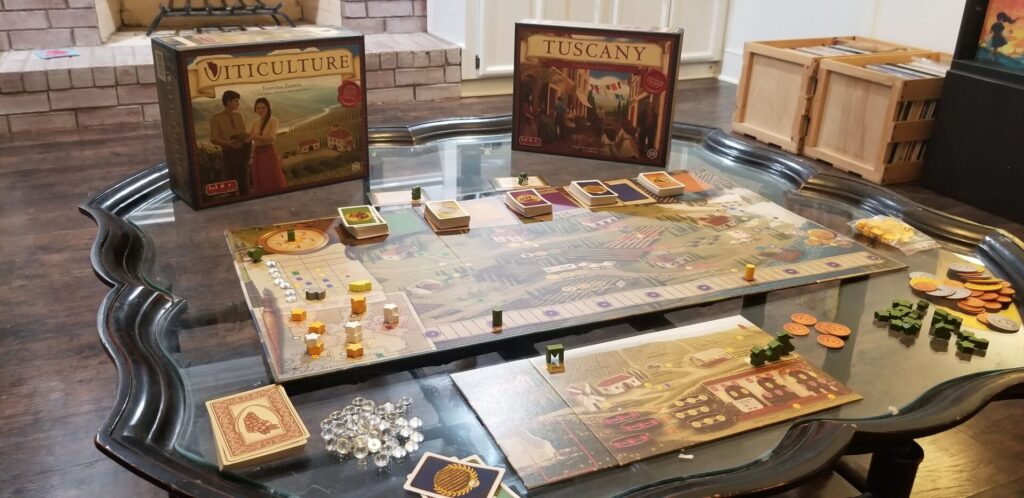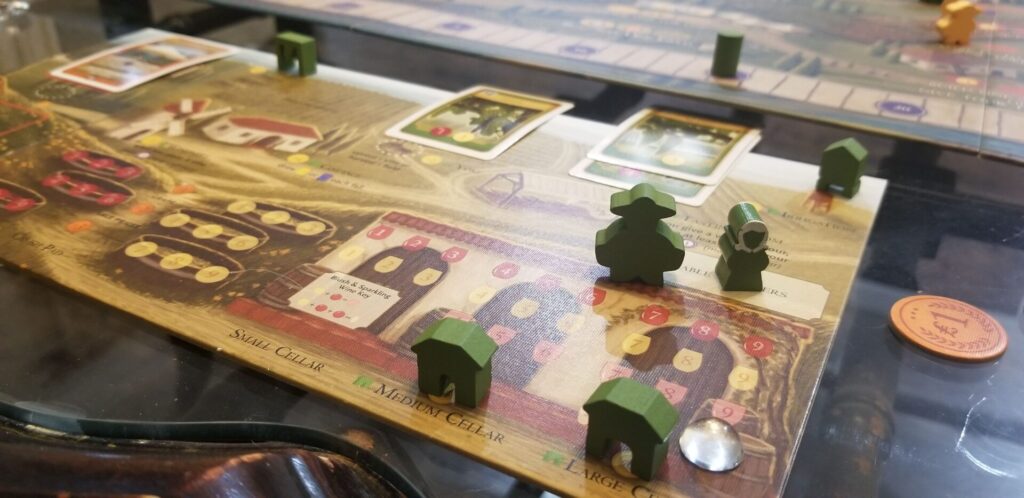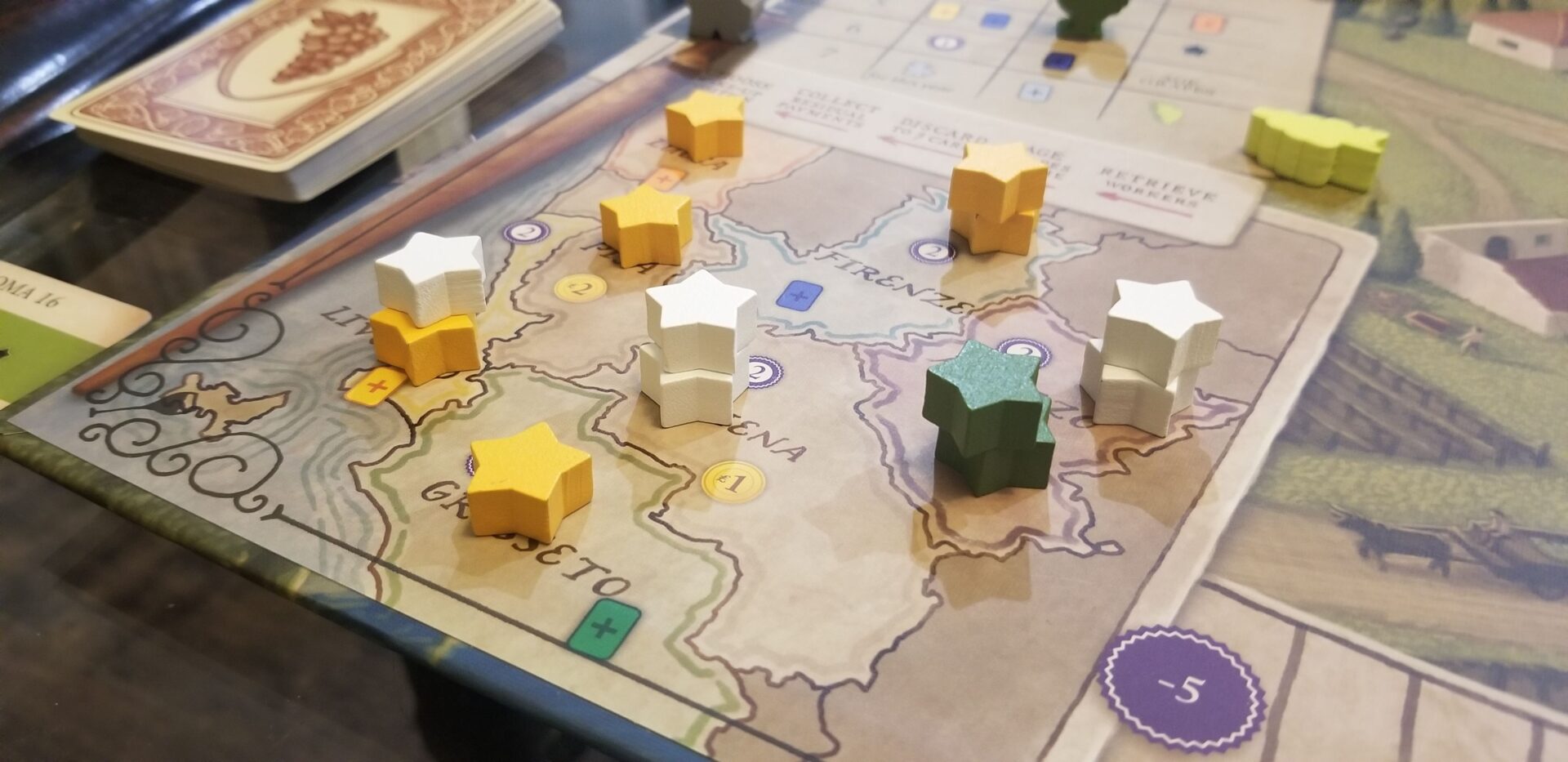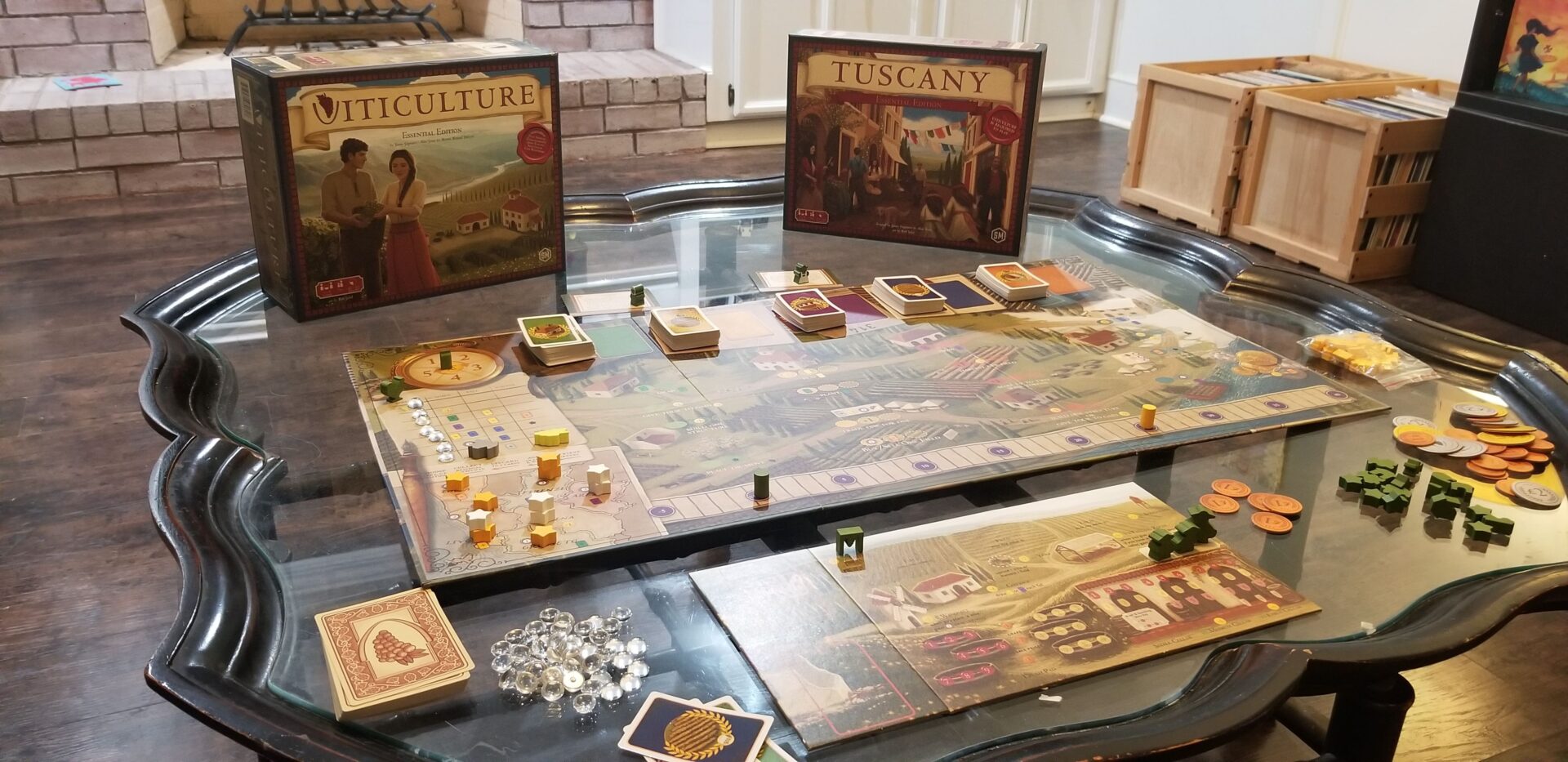
Name: Viticulture – Tuscany Essential Edition
Year of Release: 2016
Player Count: 1 – 6 Players
Playing Time: 60 – 150 minutes
Designer: Jamey Stegmaier, Alan Stone
Publisher: Stonemaier Games
Primary Mechanisms: Worker Placement, Variable Player Powers
Weight (According to boardgamegeek.com): 3.28
Review originally written on 03/27/2021 and posted as a part of the “Historic Challenge” on the Solo Games on Your Table monthly Geek List at BGG.com.
Overview
As I stroll through this “Historic Challenge”, it has come time to enter the “Age of Enlightenment.” As I’ve mentioned in my other write-ups, I don’t own a ton of truly “historically accurate” games, so I do have to get a little creative of how I slot my games to meet this challenge. This one goes out on a bit of a limb but hopefully it works. I’m choosing the Essential Edition of Viticulture with the Tuscany expansion for this portion of the challenge.
I chose this because while researching the history of winemaking in the Tuscan region of Italy, I learned that in 1716, the Duke of Tuscany established legal boundaries to localize Chianti production into one area. This was the first time a link between a wine and a territory was formalized and gave it legal protection. Since 1716 lands during the “Age of Enlightenment” what better way to celebrate this historical era than to play a nice solo round of Viticulture + Tuscany?
Viticulture + Tuscany is actually my favorite multiplayer game. My wife and I have played it more than any other game in our library, even introducing it to some “non-gamer” friends who loved the experience. Because it hits the table so much, I have never needed (or particularly wanted) to try out the solo variant. I typically play the solo variants of games that my wife does not care for, to get them to the table more and since this is not the case with Viticulture, playing the solo version has never been of interest to me. Since it does slightly fit into this historic challenge though, I figured I’d give it a shot and since I love the solo variants of Wingspan and Tapestry, and we’re talking about my favorite game here, it must be fun, right?
General Thoughts

My first time playing the solo variant was NOT fun and it was not fun because I got my butt kicked. I was in no way ready with a strategy that fit the gameplay style of the solo variant. I finished the game, defeated by the score as well as my spirit feeling defeated that I did so bad at my beloved game. I spent a few days thinking about it here and there, and then made my mind up today to try again, this time with a new strategy in place. And I won! Not by much and solely at the “regular” difficulty level but it was still a win and I felt better about my gaming prowess. I’m going to forego my normal write-up style and just put some general thoughts on the variant and how some of those thoughts changed from play one to play two.
The game is played through a set number of 7 years. This was where I made my first mistake. 7 years in Viticulture is not long at all. I guess my wife and I take our time in a normal game? We like to upgrade our cellars all the way, fill up these cellars with high value blush or sparkling wines, hire as many workers as we can, and generally just enjoy the flow of the game. The solo variant doesn’t care if you want to play at a relaxed pace. It expects you to get over 25 points within those 7 years or you’re going down, buddy. Going into play two, I realized this so I shot for filling as many small value wine orders as I could, so I didn’t have to waste time upgrading the cellars. Even lucked out with a visitor who let me make two wines above 4 value even if I didn’t have an upgraded cellar, allowing me to fill a nice blush order.
When playing through these 7 years, you can only use each track on the “wake-up chart” once. This was another facet that I was not prepared for on my first play through. I’m not sure how I feel about this part of the game when coupled with the fact that the AI Player’s workers are controlled by a deck of cards that tells you what spots to cover each season with opposing workers. This doesn’t really go with the “wake-up chart” mechanism because the opposing workers are always put out first to block you. This means, at some point you’re going to get stuck having to use the first or second track on the “wake-up chart”, but you get no advantage as you would in the multiplayer game of getting to go first that season. You might still get blocked by the opposing workers and not get any added benefits.
Speaking of the AI Player – they never take actions. Yes, the cards dictate where the workers are placed but it pretty much ends there. The AI player’s score token never moves, being put in a specific spot only varying based on the difficulty you want to play at. The AI Player also puts out a numerous amount of stars on the map and then these never change for the duration of the game. Honestly, I don’t have any better ideas of how to make the AI Player seem more realistic, but I do know that this does not at all simulate playing against a real opponent. I feel that the Automa mechanics have improved in Stonemaier Games since Viticulture was conceived.
In each of my play throughs, the AI’s workers barely hindered me at all. There are times when you turn over the next Automa card and there aren’t even any actions from the season you’re on, so the AI workers get to stay put on the sidelines. This just added to the feeling of not playing against another person though I will mention, each game there was one single moment where the AI workers blocked exactly what I needed and basically ruined my whole year.
Let me go back to the star’s mechanic briefly. In a regular multiplayer game of Tuscany, you and your opponent vie for control of different regions on the little map by placing star tokens on the regions. Each region grants a bonus and then some additional Victory Points at game’s end. In the solo variant, you are told to load up the map with the AI Player’s stars (and having to dip into two more colored bags to have enough star inventory.) On my first play through, I barely touched the map as that is never really one of my strong spots when playing. Needless to say, I got creamed by those Victory Points at the end of the game. In play two, I made sure to attack the map from the very beginning. And while I didn’t get a ton of points from these regions, I was able to tie enough regions to cancel out a majority of the AI Player’s stars.
Conclusion

In conclusion, I’m glad I went for play two in order to try out some new things in this game that I’ve played so many times, but I don’t see a need to run through this solo again. If you haven’t played it, you like worker placement games, and you have at least one other person (or a group) to play with, by all means, get it as it is fantastic. But I can’t see dropping the money for it to only play it solo as it is quite the lackluster affair.
Rating
Ratings are based on 5 main criteria: rulebook, setup, components, art & graphic design, and gameplay. The first 4 criteria are rated 1 to 5 and the gameplay is rated 1 to 10. These scores culminate in an “overall satisfaction” score that is rated from 1 to 10. If the reviewed game has both a solo and multiplayer mode, I have assigned scores separately to give context to which mode we enjoy more.
Links
As an Amazon Associate I earn from qualifying purchases.
Amazon: Tuscany Essential Edition Board Game
Amazon: Viticulture Essential Edition Board Game

